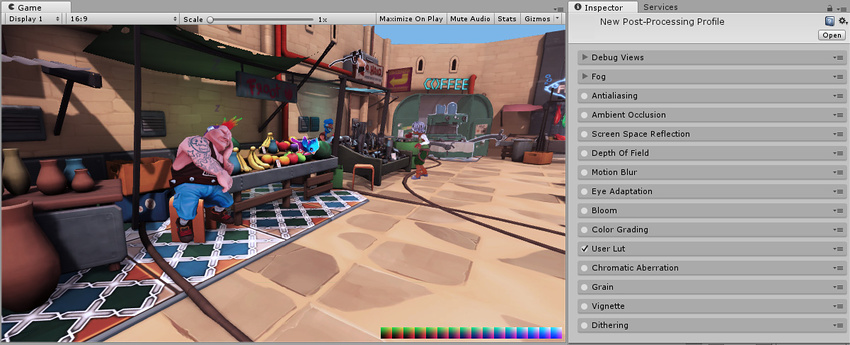User LUT
The effect descriptions on this page refer to the default effects found within the post-processing stack.
User LUT is a simpler method of color grading where pixelsThe smallest unit in a computer image. Pixel size depends on your screen resolution. Pixel lighting is calculated at every screen pixel. More info
See in Glossary on screen are replaced by new values from an LUT (or look-up texture) supplied by the user. It is a much less advanced method than the Color Grading effect. However, as this method does not require the more advanced texture formatsA file format for handling textures during realtime rendering by 3D graphics hardware, such as a graphics card or mobile device. More info
See in Glossary used by Color Grading it is recommended as a fallback for platforms that do not support these formats.



Properties
| Property: | Function: |
|---|---|
| Lut | Custom lookup texture (strip format, e.g. 256x16). |
| Contribution | Blending factor. |
Optimisation
- If using a 1024x32 texture for input, consider using a 256x16 instead
Details
User LUT uses a “strip format” texture for input. Two neutral LUTs are provided with the Post-processing stack, one at a resolution of 256x16 and another at 1024x32. Using larger input textures will affect performance.
To create an LUT import one of the neutral LUTs into an image editing tool such as Photoshop with a screenshot of your sceneA Scene contains the environments and menus of your game. Think of each unique Scene file as a unique level. In each Scene, you place your environments, obstacles, and decorations, essentially designing and building your game in pieces. More info
See in Glossary. Apply color corrections in a non destructive manner on top of these two images until you are happy with the result. Note that only pixel-local effects are supported by LUTs, meaning no blur and other effects that depends on the value of neighboring pixels. Now export the LUT with these color changes applied back into Unity to be used in the User LUT effect.
The User LUT effect will prompt you to make changes to the texture’s import settings if necessary.
You can achieve a “lo-fi” effect by manually setting the Filter Mode of the input texture to Point (no filter).

Requirements
- ShaderA small script that contains the mathematical calculations and algorithms for calculating the Color of each pixel rendered, based on the lighting input and the Material configuration. More info
See in Glossary model 3
See the Graphics Hardware Capabilities and Emulation page for further details and a list of compliant hardware.
2017–05–24 Page published with no editorial review
New feature in 5.6